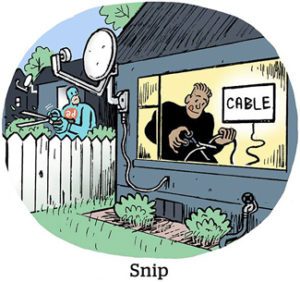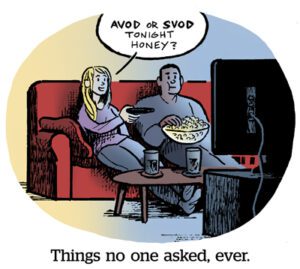Something is rotten in the state of CTV.
If you’re a fan of streaming, you probably have a few pet peeves that take you out of the zone, like repeat ads or interruptive ad breaks. Nothing ruins a good show more than thinking it’s trying to sell you something.
These problems were solved with a manual approach on linear TV, said Joe Hirsch, General Manager of SpringServe, a CTV ad server that was acquired by Magnite last year. Once upon a time, an operator would literally sit and watch the ad breaks in conjunction with the surrounding content before it aired on linear television. There was a real person approving ad breaks on a single, standardized operating system. (Cue the laugh track.)
Connected TV is much more complex because audiences control their own viewing experiences. Watching what we want on more platforms than we care to count calls for automation. In other words, the good ol’ days of someone sampling our content before it’s served to us are long gone.
Industry experts spoke with AdExchanger about streaming audiences’ most common pet peeves – and the technology gaps behind them.
Pet Peeve #1: Overfrequency
To understand repeat ads, you’ll need to consider all the different parties competing for your attention. Imagine yourself surrounded by paparazzi.
Whenever you consume ad-supported CTV, every company with a stake in that content gets to show you an ad. If you’re watching Pluto TV with an Amazon Fire Stick, for example, Pluto and Amazon are first in line to serve you an ad, said Brad Stockton, SVP of US and national video innovation at Dentsu.
Publishers that sell inventory programmatically turn a portion over to third-party media buyers bidding for the chance to serve you an ad. These buyers on the open exchange have access to a lot of overlapping inventory – the golden recipe for repetition.
This overlap isn’t just a matter of advertisers not setting proper frequency caps on their buys, Stockton said. It’s more a question of communication – or lack thereof.
Publishers, distributors and SSPs stay compliant with their own frequency capping rules – even if their ads overlap with each other on a given show – because they’re not talking to each other, Stockton said. They each successfully serve their own ads regardless of what’s going on in the rest of that ad pod.
“It’s the technical limitation of server-side ad insertion,” Stockton added.
One reason these different groups don’t talk to each other is because of the technical challenges around classifying ad creatives and sharing that information.
“When the world was all direct campaigns, it was pretty easy,” said Benjamin Antier, co-founder and CEO of Publica, a CTV ad server recently acquired by Integral Ad Science. “But now you have [dozens of] SSPs working with hundreds of DSPs that all have their own ways of classifying ads and recognizing creatives.”
But, then again, perception tends to become reality.
Repetition: Believe it or not?
The truth is, ad repetition doesn’t actually happen nearly as often as we think it does, according to data from Comcast-owned FreeWheel.
“We have the data from most of the premium experience, and [back-to-back ad repetition] happens way less than people think,” said David Dworin, FreeWheel VP of product management. “It’s less than 3% [of the time]. Sometimes even less than 1%.”
If the same ad kicks off multiple commercial breaks in one sitting, even if that sitting is actually an hours-long binge sesh, viewers know when they’ve seen an ad before and tend to interpret it as repetitive, even if the ad isn’t technically playing back-to-back.
People also tend to group together different ads from the same advertiser, said Louqman Parampath, VP of product management for advertising at Roku.
For example, BMW might be running campaigns for its luxury sedan and its SUV at the same time. While technically two different ads, running both in the same commercial break will likely just leave a user feeling bombarded by BMW.
Pet Peeve #2: Interruptive ad breaks
Ad breaks that cut off dialogue midsentence during a program are never a good look.
Even though linear TV became addressable, there’s consistency because a set-top box knows where to insert an ad for an MVPD (multichannel video programming distributor) selling the ad break, said Nicole Whitesel, EVP of advanced TV and client success at Publicis Media.
But on-demand streamers who work with a bevy of partners would have to go through hundreds of pieces of content in their libraries to mark up those ad breaks manually. Not all streaming platforms have completed that process or calibrated ad breaks to the lighter ad loads in CTV.
“TV started out with every partner negotiating their own format and timing [for their own content],” Whitesel said, “so it’s going to take some time to reach that level of consistency [on AVOD].”
Ads that cut off someone midsentence are more likely to occur while viewing lower-quality or more niche content.
“Really good content comes with [information about] where an ad break belongs,” Parampath said. But if not, adding in ad breaks can provide “an opportunity for those platforms to catalog the content they’re bringing on from each partner [to determine] a more consistent way to deliver ad breaks,” Whitesel added.
However, publishers shouldn’t be hard coding ad break intervals, Parampath added, because it almost always makes for a bad viewing experience – that information should come with the content.
“Getting those cue points right is a manual process,” Dworin said. “People use machine learning, but for the most part, someone has to go in there and say, ‘This is where the ad should be.’”
But, again, that’s easier said than done for on-demand platforms with content libraries boasting tens of thousands of hours of content.
Pet Peeve #3: “We’ll be back” slates
It’s 2022. Are your favorite shows still hitting you with a static “We’ll be back” message? The show might come back, but you probably won’t.
Slates are much more common during live, streamed on AVOD platforms. Platforms have a finite amount of inventory to sell, and they historically sell it ahead of time, Stockton said.
But live content is inherently way less predictable. A soccer match going into overtime, for example, would call for more ad pods than the platform was ready for, resulting in a slate.
On top of that, the inherent unpredictability of live content means there are more brands unwilling to advertise in live environments, Parampath said. The news is especially daunting and risky for advertisers.
Conversely, VOD (video on demand) inventory is sold both upfront and programmatically, so on-demand platforms are overall less likely to find themselves with unsold inventory, Whitesel said.
Instead of a “We’ll be back” slate, many programmers handle unsold spaces in more seamless ways. An on-demand platform could show a house ad in an unsold pod or even skip the ad break altogether.
House ads, while not profitable for the publisher, keep the viewing experience seamless without revealing it’s trying and failing to sell you something.
So, to answer your burning question: No, advertisers aren’t trying to annoy you by interrupting your favorite shows. It’s actually a lot more profitable not to annoy you.
CTV is still in its infancy compared to the traditional TV viewing experience we’re all used to, so these streaming grievances – while valid – represent what got lost in translation. Long story short, TV viewing norms have changed drastically in the last few years, and it’s going to take a little more time for the technology to catch up.
This article has been updated.

















